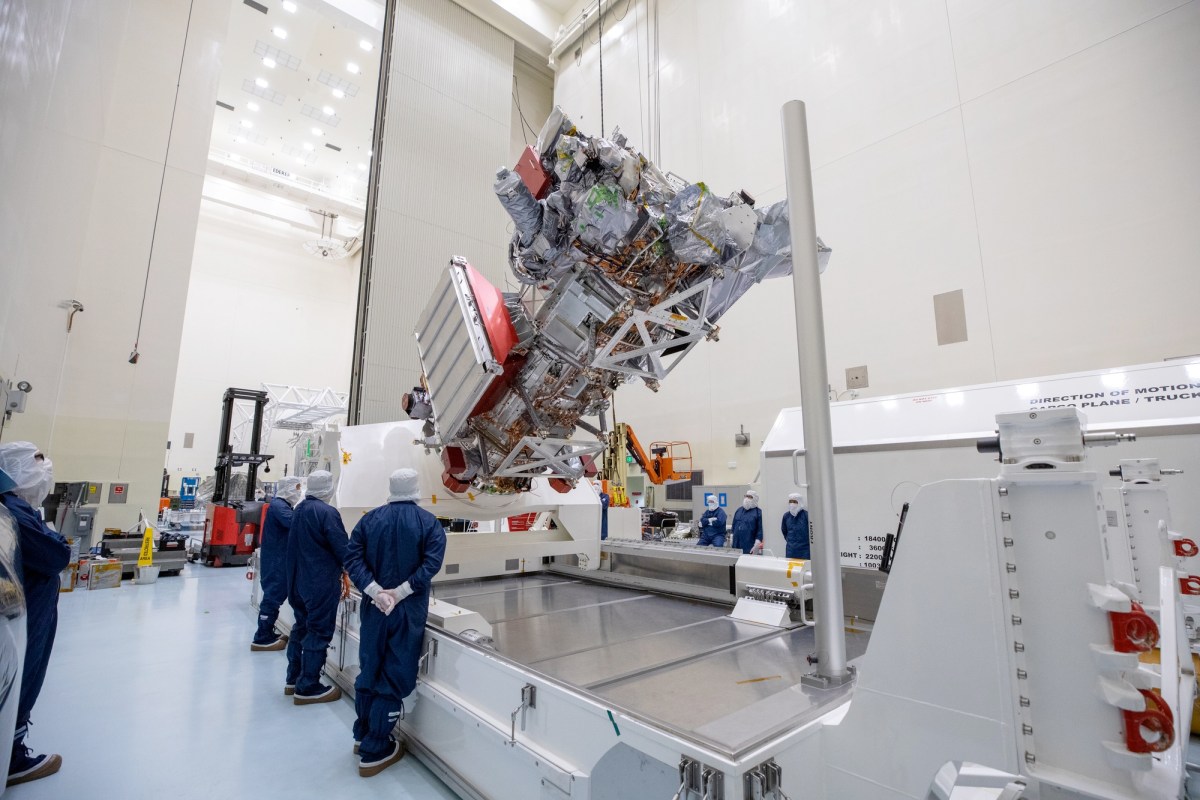BUSAN, South Korea — The head of NASA’s science directorate says she remains optimistic the Europa Clipper mission will launch on schedule in October despite concerns about the spacecraft’s electronics and its launch vehicle.
The $5 billion mission is scheduled to launch on a SpaceX Falcon Heavy during a three-week window that opens Oct. 10. The spacecraft will go into orbit around Jupiter in 2030 and make dozens of close approaches to Europa, an icy moon that has a potentially habitable subsurface ocean.
NASA announced July 11 that the mission was studying transistors on the spacecraft that may not have the level of radiation tolerance required for the mission, based on experience with similar components used elsewhere. Jupiter’s powerful magnetic field creates high doses of radiation in the form of charged particles for spacecraft in its vicinity, including around Europa.
“Testing data obtained so far indicates some transistors are likely to fail in the high-radiation environment near Jupiter and its moon Europa because the parts are not as radiation resistant as expected,” the agency stated. “The team is working to determine how many transistors may be susceptible and how they will perform in-flight. NASA is evaluating options for maximizing the transistors’ longevity in the Jupiter system.”
NASA did not disclose details on the options it was considering, other than a preliminary analysis would be completed in late July. Those options, industry sources said, could include replacing the transistors, which would mean that the mission would miss its October launch window.
An additional complication comes from the anomaly on a Falcon 9 launch late July 11 where the vehicle’s upper stage engine malfunctioned, deploying the rocket’s payload of Starlink satellites in an orbit too low for the spacecraft to survive. SpaceX has grounded the rocket while it investigates the failure, which also affects the Falcon Heavy with its similar upper stage.
Despite those challenges, Nicky Fox, NASA associate administrator for science, said she remains optimistic about the prospects of launching the mission on schedule. “We’re going to continue to charge towards the launch as long as we can, look at all of the options and make a decision,” she said in an interview after a talk at the Committee on Space Research (COSPAR) 45th Scientific Assembly here July 16.
She added there is no deadline short of the launch period itself for deciding to proceed with the launch. “We will keep marching towards that Oct. 10 launch window, and at some point that decision will be made for us.”
“I’m ever hopeful,” she said. “The team is working so hard, and they’re so motivated.”
Mars Sample Return status
During her talk at the COSPAR meeting, Fox also addressed the Mars Sample Return (MSR) program. NASA announced in April that it would look for new options to carry out the mission in an effort to reduce its cost and schedule, and awarded study contracts to seven companies in June to look at alternatives, along with efforts by the Jet Propulsion Laboratory, Applied Physics Laboratory and a group of NASA centers.
“We have adapted. We have realized that we have a challenge,” she said of MSR. She argued it was limited to the “middle third” of the overall effort, which involves retrieving samples collected by the Perseverance rover and launching them into Martian orbit, where the European-built Earth Return Orbiter (ERO) will collect them and take them back to Earth.
“They’ve already done a third of the mission,” she said, referring to the samples already collected by Perseverance. “We’ve done a large chunk of the mission and we’ve done a very challenging part of the mission.”
The final third of the mission, returning the samples back to Earth, “is already planned,” she added. ESA is pushing ahead with development of ERO, announcing July 5 that the spacecraft has completed its critical design review.
“Getting that second third is where we’re all focusing on,” Fox said. “I really welcome the challenge.”
“We’re looking at innovation. We’re looking at outside-the-box thinking,” she added. “We’re also looking deeply inside the box: is there some simple thing that we missed?”
Neither NASA nor the organizations selected for design studies have disclosed many details about their plans, although several appear focused on the Mars Ascent Vehicle (MAV), the rocket that will launch the sample canister into orbit around Mars.
In a separate presentation at COSPAR July 15, Laurie Leshin, director of JPL, said her lab is looking at ways to adapt the “skycrane” landing system demonstrated on the Curiosity and Perseverance rover missions for MSR. Doing so, she said, requires reducing the mass of the sample retrieval lander and the MAV it carries, but if that is possible, she argued it could significantly reduce the cost and complexity of the mission.
